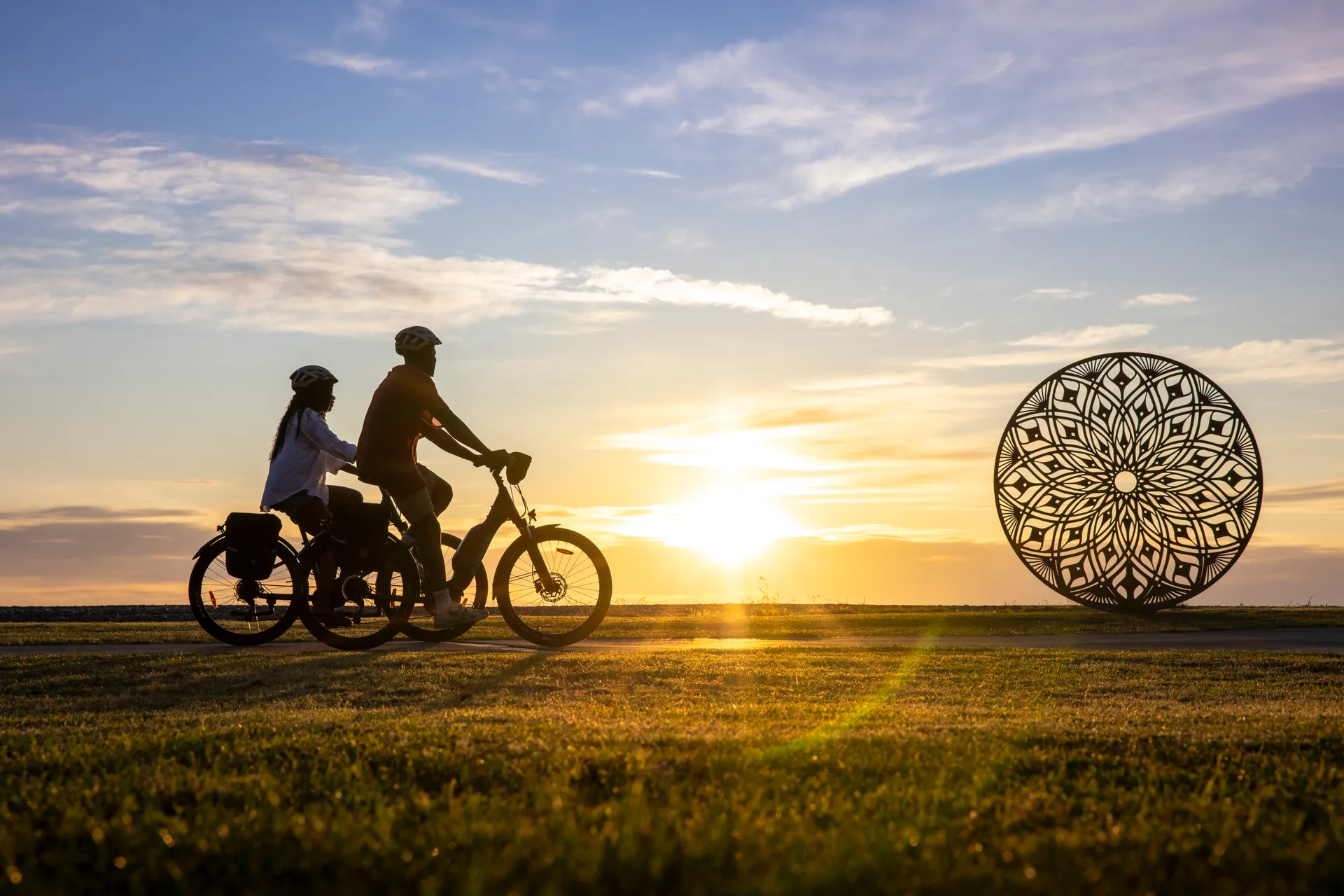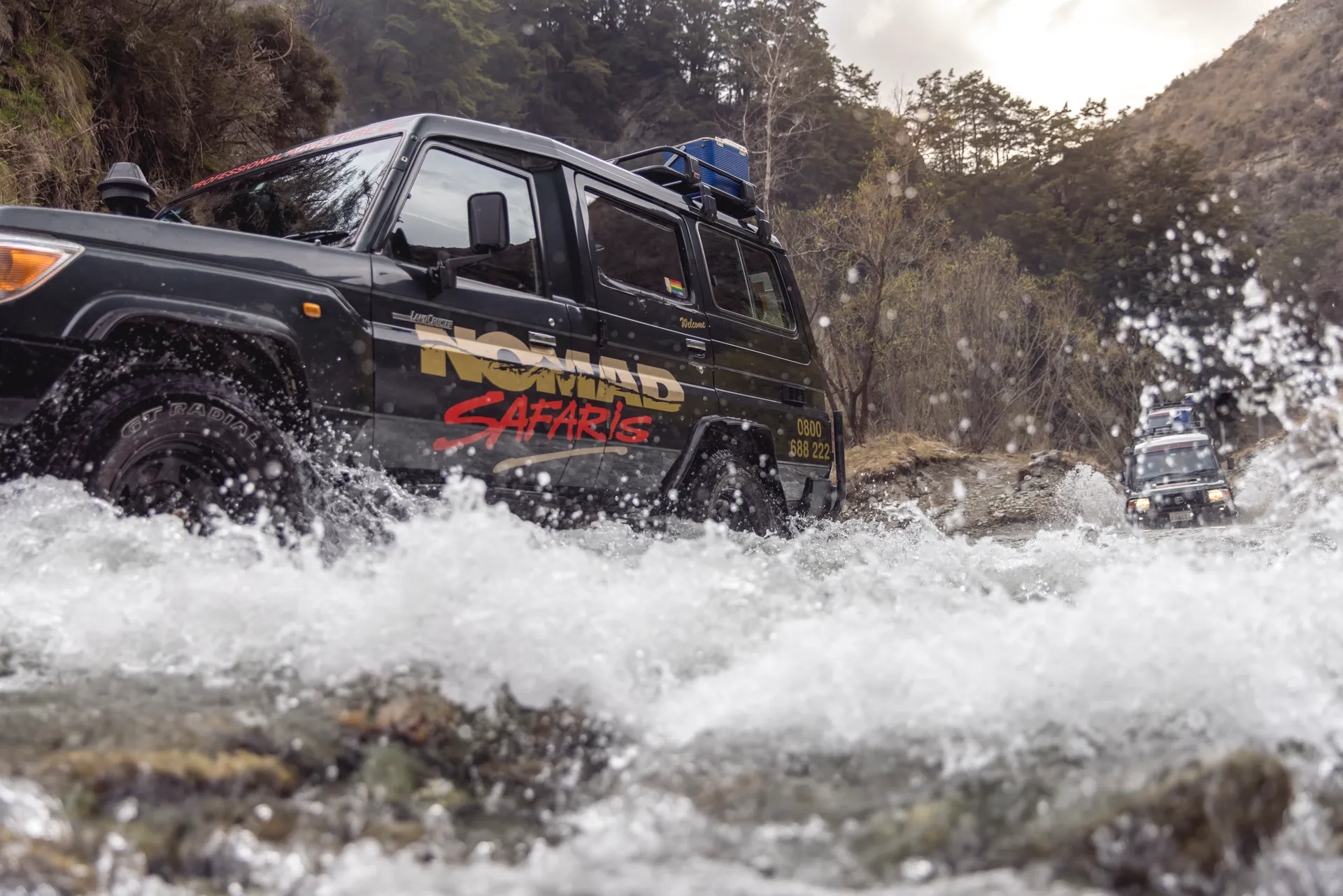Best Time to Visit New Zealand: Complete 2026 Month-by-Month Guide
“What is the best time to visit New Zealand?”
The best time to visit New Zealand is during the summer months, from December to March.
Although, it’s worth noting that New Zealand is a fantastic holiday destination throughout the year, and most parts of the country only have temperature differences of around 10°C between summer and winter. The country has four distinct seasons, namely Spring (September to November), Summer (December to February), Autumn (March to May), and Winter (June to August).
Summer Season
The best time to visit New Zealand is during the summer season (December to March) when the days are long, bright, and sunny, and the temperatures range from 16°C to 24°C. Visitors can enjoy the stunning beaches and take part in various outdoor activities like hiking and mountain biking. Water-based activities such as rafting, snorkeling, diving, and kayaking are also popular during the summer season.
Winter Season
On the other hand, during the winter season (June to August), the mountains get snow, providing excellent skiing opportunities. However, outside the mountains, New Zealand winters are mild, and temperatures typically don’t go below freezing.
All in all, New Zealand is an excellent place to visit throughout the year, with each season providing unique experiences and activities.
New Zealand’s Four Distinct Seasons & Average Temperatures

Spring
September to November – Average daytime temperature: 16 – 19˚C (61 – 66˚F)

Summer
December – February – Average daytime temperature: 20 – 25˚C (68 – 77˚F)

Autumn
March to May – Average daytime temperature: 17 – 21˚C (62 – 70˚F)

Winter
June to August – Average daytime temperature: 12 – 16˚C (53 – 61˚F)
The best time to visit New Zealand depends on what you want to experience. For warm weather and outdoor adventures, summer (December to February) is ideal. For fewer crowds and better prices, the shoulder seasons of autumn (March to May) and spring (September to November) offer excellent value. Winter (June to August) is perfect for skiing and snow sports.
This comprehensive guide breaks down everything you need to know about New Zealand’s seasons, weather patterns, and the best times for specific activities to help you plan your perfect Kiwi adventure.
Quick Answer: When Should You Visit New Zealand?
- Best Overall: December to February (Summer) – warm weather, long days, perfect for beaches and hiking
- Best Value: March to May, September to November (Shoulder seasons) – mild weather, fewer tourists, lower prices
- Best for Skiing: June to August (Winter) – snow season in Queenstown and Mt Ruapehu
- Best for Fewer Crowds: May to June, August to September – off-peak with reasonable weather
Table of Contents
- Understanding New Zealand’s Seasons
- Month-by-Month Weather Guide
- Best Time by Activity
- Regional Differences: North vs South Island
- Budget Considerations
- Frequently Asked Questions
Understanding New Zealand’s Seasons
New Zealand sits in the Southern Hemisphere, meaning its seasons are opposite to North America and Europe. When it’s winter in New York or London, it’s summer in Auckland and Queenstown.
Summer (December to February)
Weather: 20-30°C (68-86°F)
Peak tourist season with the warmest temperatures and longest daylight hours (up to 15 hours of daylight). Perfect beach weather and ideal conditions for hiking, water sports, and exploring both islands.
Pros:
- Best weather for outdoor activities
- All attractions and tours operating
- Vibrant atmosphere with festivals and events
- Long evenings to enjoy sightseeing
Cons:
- Highest prices for accommodation and flights
- Crowded popular attractions
- Advance booking essential
- School holidays increase family travelers
Autumn (March to May)
Weather: 10-20°C (50-68°F)
Shoulder season bringing stunning fall colors, especially in Central Otago and Canterbury. Stable weather with warm days and cooler evenings.
Pros:
- Beautiful golden foliage
- Fewer tourists than summer
- Lower accommodation prices
- Still warm enough for most activities
- Excellent wine harvest season
Cons:
- Days getting shorter
- Some alpine roads may close in late May
- Water temperatures cooling down
Winter (June to August)
Weather: 0-15°C (32-59°F)
Off-peak season except in ski resort areas. Cold temperatures, especially in the South Island, with snow in mountain regions.
Pros:
- World-class skiing and snowboarding
- Lowest prices for accommodation
- Minimal crowds at non-ski attractions
- Cozy atmosphere in mountain towns
- Best time for aurora viewing in South Island
Cons:
- Cold and wet weather
- Shorter daylight hours (9-10 hours)
- Some hiking trails and mountain passes closed
- Limited beach activities
Spring (September to November)
Weather: 10-20°C (50-68°F)
Shoulder season with warming temperatures, blooming wildflowers, and newborn lambs in the countryside. Weather can be unpredictable.
Pros:
- Spring flowers and green landscapes
- Moderate prices
- Increasing daylight hours
- Good hiking conditions
- Baby animals at farms
Cons:
- Variable weather patterns
- Can still be cold, especially early spring
- Some snow lingering at high altitudes
Month-by-Month Guide to Visiting New Zealand
January – Peak Summer
Temperature: 20-25°C (68-77°F)
Rainfall: Low to moderate
Crowds: Very High
The hottest and busiest month in New Zealand. Perfect for beaches, coastal activities, and multi-day hikes. Book everything well in advance.
Best for: Beach holidays, water sports, Great Walks, festivals
Events: Auckland Anniversary Day, Wellington Cup
February – Late Summer
Temperature: 20-25°C (68-77°F)
Rainfall: Low to moderate
Crowds: Very High
Similar to January with excellent weather. Still peak season with high prices but slightly fewer international tourists as schools restart globally.
Best for: Diving, swimming, hiking, wine tours
Events: Marlborough Wine & Food Festival, Art Deco Weekend in Napier
March – Early Autumn
Temperature: 15-22°C (59-72°F)
Rainfall: Moderate
Crowds: Moderate
Shoulder season begins with beautiful autumn colors emerging. Prices start to drop and crowds thin out while weather remains pleasant.
Best for: Scenic drives, wine regions, photography, hiking
Events: Pasifika Festival Auckland, WOMAD Taranaki
April – Mid Autumn
Temperature: 12-19°C (54-66°F)
Rainfall: Moderate
Crowds: Low to Moderate
Fantastic time to visit with stunning fall foliage, especially in Arrowtown and Wanaka. Comfortable temperatures for walking and sightseeing.
Best for: Autumn foliage tours, thermal pools, wildlife watching
Events: Bluff Oyster Festival, Arrowtown Autumn Festival
May – Late Autumn
Temperature: 10-17°C (50-63°F)
Rainfall: Moderate to High
Crowds: Low
Transitioning to winter with cooler temperatures. Excellent value for money with low season prices beginning. First snow appears in mountains.
Best for: Budget travel, hot springs, cultural attractions, museums
Events: New Zealand International Comedy Festival
June – Early Winter
Temperature: 7-14°C (45-57°F)
Rainfall: High
Crowds: Low (except ski areas)
Winter arrives with ski season opening mid-month. Cold and wet in most regions but exciting for snow sport enthusiasts.
Best for: Skiing, snowboarding, cozy cafes, aurora hunting
Events: Matariki (Māori New Year), Queenstown Winter Festival
July – Mid Winter
Temperature: 6-13°C (43-55°F)
Rainfall: High
Crowds: Moderate (ski areas busy)
Peak ski season with excellent snow conditions. Cheapest time for non-winter activities but cold weather limits some experiences.
Best for: Winter sports, budget city breaks, hot pools
Events: Queenstown Winter Festival continues
August – Late Winter
Temperature: 7-14°C (45-57°F)
Rainfall: High
Crowds: Low to Moderate
Still ski season but spring approaching. Days gradually getting longer and warmer toward month’s end.
Best for: Late ski season deals, whale watching (Kaikoura), hot springs
Events: Beervana Wellington, various ski competitions
September – Early Spring
Temperature: 10-16°C (50-61°F)
Rainfall: Moderate
Crowds: Low
Spring begins with unpredictable weather. Wildflowers blooming and lambing season in countryside. Good value with shoulder season prices.
Best for: Hiking, wildlife tours, spring flowers, farm visits
Events: World of WearableArt Awards Show
October – Mid Spring
Temperature: 12-18°C (54-64°F)
Rainfall: Moderate
Crowds: Moderate
Beautiful spring weather with longer days. Gardens and parks in full bloom. Increasingly popular as travelers seek shoulder season value.
Best for: Garden tours, hiking, cycling, adventure activities
Events: Toast Martinborough Wine Festival
November – Late Spring
Temperature: 14-20°C (57-68°F)
Rainfall: Moderate
Crowds: Moderate to High
Warming up nicely with consistently good weather. Pre-summer crowds begin arriving. Still good value before peak season.
Best for: All outdoor activities, whale watching, scenic flights
Events: Christchurch Cup & Show Week
December – Early Summer
Temperature: 17-23°C (63-73°F)
Rainfall: Low to Moderate
Crowds: High
Summer arrives with school holidays starting mid-month. Prices increase but weather is generally excellent. Book accommodation early.
Best for: Beaches, hiking, water sports, all outdoor activities
Events: Christmas festivities, New Year celebrations
Best Time to Visit New Zealand by Activity
Hiking and Tramping
Best Time: October to April
The Great Walks (Milford Track, Routeburn Track, Kepler Track) are best tackled in summer and shoulder seasons. Huts and trails are open, weather is more stable, and river crossings are safer. December through March offers the longest days for extended hikes.
Skiing and Snowboarding
Best Time: June to September
Peak snow season runs from July to August. Major ski fields include Queenstown (The Remarkables, Coronet Peak), Wanaka (Cardrona, Treble Cone), and Mt Ruapehu (Turoa, Whakapapa) in the North Island. Book accommodation early in ski towns.
Beach and Water Activities
Best Time: December to March
Ocean temperatures reach 19-21°C (66-70°F) in summer, perfect for swimming, surfing, diving, and snorkeling. The Bay of Islands, Coromandel Peninsula, and Abel Tasman are beach hotspots.
Wildlife Watching
Best Time: Varies by species
- Whales (Kaikoura): June to August (peak), year-round viewing possible
- Dolphins: October to April
- Penguins (Otago Peninsula): September to February (breeding season)
- Seals: Year-round, best viewing November to March
- Albatross: September to March (breeding season)
Wine Tours
Best Time: February to April
Harvest season brings vineyards to life with autumn colors and wine festivals. Marlborough, Central Otago, and Hawke’s Bay are prime wine regions. Summer (December to February) also excellent with warm weather.
Adventure Activities (Bungy, Skydiving, etc.)
Best Time: October to April
Most adventure activities run year-round, but summer and shoulder seasons offer best weather conditions and visibility. Queenstown, the adventure capital, is busiest December to February.
Photography
Best Time: March to May (autumn colors) or September to November (spring blooms)
Autumn provides golden landscapes and dramatic light, particularly in Central Otago. Spring offers lush greenery, wildflowers, and clearer skies after winter.
North Island vs South Island: Regional Timing
North Island Best Times
Auckland & Bay of Islands
- Best: December to March (warm, beach weather)
- Avoid: June to August (cold, wet)
- Climate: Subtropical, milder than South Island
Rotorua & Taupo
- Best: October to April (warm, ideal for outdoor activities)
- Winter Bonus: Hot pools especially appealing June to August
- Climate: Inland, cooler than coast
Wellington
- Best: November to April (less wind, warmer)
- Known for: Wind year-round, prepare for layers
- Climate: Temperate, variable weather
South Island Best Times
Christchurch & Canterbury
- Best: November to March (driest months)
- Avoid: June to July (coldest, wettest)
- Climate: Moderate, four distinct seasons
Queenstown & Wanaka
- Best: December to February (summer activities) OR June to August (skiing)
- Shoulder Seasons: March-April and September-October for fewer crowds
- Climate: Alpine, cold winters, warm summers
Fiordland & Milford Sound
- Best: December to February (warmer, longer days)
- Reality Check: Rainfall year-round (6-8 meters annually)
- Tip: Rain creates dramatic waterfalls – embrace it!
West Coast
- Best: January to March (drier months)
- Expect: Rain possible any time
- Climate: Wettest region, lush rainforests
Dunedin & Otago Peninsula
- Best: December to February (wildlife, warmer weather)
- Spring Bonus: September to November for albatross breeding
- Climate: Cool temperatures year-round
Budget Considerations: When to Save Money
Cheapest Time to Visit New Zealand
May to September (excluding July school holidays) offers the lowest prices on:
- International flights (up to 30-40% cheaper than December)
- Accommodation (50-70% lower than peak season)
- Car rentals (significant discounts)
- Tour packages and activities
Most Expensive Time
December 26 to January 31 coincides with:
- New Zealand summer school holidays
- International peak travel season
- Limited availability requires 6-12 months advance booking
- Prices can be 2-3x higher than off-peak
Shoulder Season Sweet Spot
March to April and September to November provide the best balance:
- 20-30% cheaper than summer
- Good weather still likely
- Fewer tourists at attractions
- Better availability for popular experiences
Money-Saving Tips by Season
- Book early: 6+ months for summer travel
- Travel mid-week: Cheaper flights and accommodation
- Avoid school holidays: Both NZ (mid-December to late January, mid-April, July, late September to early October) and international holidays
- Consider house swapping or camping: Budget accommodation options
- Cook your own meals: Groceries reasonably priced
Special Events and Festivals by Season
Summer Events
- New Year’s Eve celebrations (nationwide)
- Waitangi Day (February 6) – national holiday
- Art Deco Weekend, Napier (February)
- Marlborough Wine & Food Festival (February)
Autumn Events
- WOMAD Taranaki (March)
- Pasifika Festival, Auckland (March)
- Arrowtown Autumn Festival (April)
- Bluff Oyster Festival (May)
Winter Events
- Matariki (Māori New Year, June/July)
- Queenstown Winter Festival (June/July)
- NZ International Film Festival (July/August)
Spring Events
- World of WearableArt, Wellington (September/October)
- Toast Martinborough (November)
- Christchurch Cup & Show Week (November)
Packing Essentials by Season
Summer Packing List
- Light clothing, shorts, t-shirts
- Swimwear and beach gear
- Sunscreen (high SPF – NZ sun is strong)
- Sunglasses and hat
- Light rain jacket (weather changes quickly)
- Hiking boots and sandals
Winter Packing List
- Warm layers, thermal underwear
- Waterproof jacket and pants
- Warm hat, gloves, scarf
- Sturdy waterproof boots
- Ski gear (if not renting)
Year-Round Essentials
- Layers (weather changes quickly)
- Rain jacket (always)
- Comfortable walking shoes
- Insect repellent (sandflies at South Island west coast)
- Reusable water bottle
- Power adapter (NZ uses Type I plugs)
Frequently Asked Questions
What is the best month to visit New Zealand?
January and February offer the best weather overall with warm temperatures and long days, perfect for outdoor activities. However, December, March, and April also provide excellent conditions with fewer crowds and better value.
Is New Zealand better in summer or winter?
Summer (December to February) is better for most tourists wanting warm weather, hiking, and beach activities. Winter (June to August) is better for skiing, budget travelers, and those wanting to avoid crowds. Choose based on your priorities.
What is the cheapest month to go to New Zealand?
June and August are typically the cheapest months, with significantly lower flight and accommodation prices. May and September also offer good value while avoiding the coldest winter weather.
Can you visit New Zealand year-round?
Yes, New Zealand is a year-round destination. Each season offers different experiences – summer for beaches and hiking, winter for skiing, and shoulder seasons for value and moderate weather. Some alpine roads and hiking trails close in winter.
When is the rainy season in New Zealand?
New Zealand doesn’t have a distinct rainy season. Rain occurs year-round, with winter (June to August) generally wetter than summer. The West Coast of the South Island is New Zealand’s wettest region and receives rain throughout the year.
How long should I spend in New Zealand?
Minimum 10-14 days to see highlights of both islands. Three weeks is ideal for a comprehensive trip without rushing. One island only: 7-10 days. Plan more time if visiting during winter when driving takes longer.
Do I need to book accommodation in advance?
Yes, especially for summer travel (December to February). Book 3-6 months ahead for popular areas like Queenstown, Milford Sound, and Bay of Islands during peak season. Shoulder and off-peak seasons offer more flexibility.
What is shoulder season in New Zealand?
Shoulder seasons are March to May (autumn) and September to November (spring). These periods offer mild weather, fewer tourists, lower prices, and are increasingly popular with savvy travelers seeking the best value.
Final Recommendations: When Should You Visit?
Choose Summer (Dec-Feb) if you want:
- Best weather guaranteed
- All activities and attractions open
- Beach and water activities
- Long daylight hours
- Don’t mind crowds and higher prices
Choose Autumn (Mar-May) if you want:
- Beautiful scenery with fall colors
- Good weather with fewer tourists
- Better value for money
- Wine harvest season
- Pleasant hiking conditions
Choose Winter (Jun-Aug) if you want:
- Skiing and snowboarding
- Lowest prices
- Minimal crowds (except ski resorts)
- Cozy mountain town atmosphere
- Don’t mind cold weather
Choose Spring (Sep-Nov) if you want:
- Wildflowers and green landscapes
- Moderate prices and crowds
- Increasingly good weather
- Baby animals on farms
- Can handle variable weather
Ready to Plan Your New Zealand Adventure?
The best time to visit New Zealand truly depends on your interests, budget, and travel style. Summer offers unbeatable weather but comes with crowds and high prices. Shoulder seasons provide excellent value while still enjoying good conditions. Even winter has its appeal for snow enthusiasts and budget travelers.
No matter when you choose to visit, New Zealand’s stunning landscapes, friendly locals, and incredible experiences await. Start planning early, especially for summer travel, and prepare for a trip of a lifetime in one of the world’s most beautiful countries.
Pro Tip: New Zealand weather is notoriously changeable. Regardless of when you visit, pack layers and be prepared for “four seasons in one day.” This adaptability will ensure you enjoy your Kiwi adventure to the fullest, rain or shine.
This guide is updated regularly to reflect current travel conditions and seasonal information. Always check official sources for the latest travel advisories and weather forecasts before your trip.
EXPLORE
New Zealand Tour Packages & Categories
New Zealand Tour Packages
New Zealand Tour Package Deals 2026/2027
Are you looking for deals? Book early and save up to 10% on your next New Zealand tour package. If you are interested in discounted tours in New Zealand, fill out our Inquiry form and we will send you our best offer.






